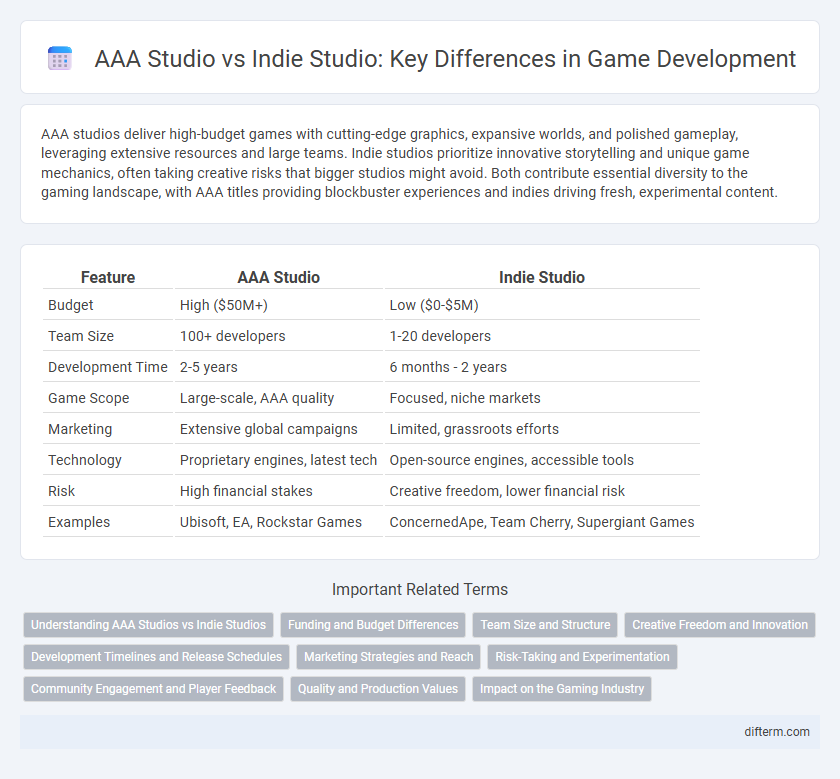AAA studios deliver high-budget games with cutting-edge graphics, expansive worlds, and polished gameplay, leveraging extensive resources and large teams. Indie studios prioritize innovative storytelling and unique game mechanics, often taking creative risks that bigger studios might avoid. Both contribute essential diversity to the gaming landscape, with AAA titles providing blockbuster experiences and indies driving fresh, experimental content.
Table of Comparison
| Feature | AAA Studio | Indie Studio |
|---|---|---|
| Budget | High ($50M+) | Low ($0-$5M) |
| Team Size | 100+ developers | 1-20 developers |
| Development Time | 2-5 years | 6 months - 2 years |
| Game Scope | Large-scale, AAA quality | Focused, niche markets |
| Marketing | Extensive global campaigns | Limited, grassroots efforts |
| Technology | Proprietary engines, latest tech | Open-source engines, accessible tools |
| Risk | High financial stakes | Creative freedom, lower financial risk |
| Examples | Ubisoft, EA, Rockstar Games | ConcernedApe, Team Cherry, Supergiant Games |
Understanding AAA Studios vs Indie Studios
AAA studios are large-scale developers with significant budgets, extensive teams, and advanced technology, enabling them to produce high-quality, blockbuster games with elaborate graphics and complex gameplay mechanics. In contrast, indie studios are smaller, often consisting of passionate developers focusing on innovative, creative, and niche gaming experiences, frequently leveraging limited budgets and digital distribution platforms. Understanding the differences highlights how AAA studios drive mass-market appeal and high production values, while indie studios prioritize originality and artistic expression within the gaming industry.
Funding and Budget Differences
AAA studios operate with multi-million dollar budgets often exceeding $50 million, enabling access to cutting-edge technology, extensive marketing campaigns, and large development teams. Indie studios rely on smaller funding sources such as crowdfunding, personal savings, or small investors, resulting in budgets typically under $5 million. This budget disparity significantly affects project scope, production quality, and release timelines between AAA and indie games.
Team Size and Structure
AAA studios typically feature large teams of 100 to 1,000+ professionals with specialized roles in design, programming, art, and production pipelines, enabling complex game development and high-budget projects. Indie studios often operate with small teams ranging from 1 to 20 members, where individuals multitask across multiple roles, fostering creative freedom but limiting scope and resources. The structured hierarchy in AAA development contrasts sharply with the flat, flexible organization in indie studios, affecting workflow efficiency and innovation potential.
Creative Freedom and Innovation
Indie studios often embrace creative freedom, allowing developers to experiment with unique gameplay mechanics and innovative storytelling without the constraints of large budgets or publisher demands. AAA studios typically focus on high production values and proven formulas, which can limit risk-taking but ensure polished experiences for mass audiences. The contrast between these approaches drives diversity in the gaming industry, with indie studios pushing creative boundaries while AAA studios deliver expansive, technically advanced titles.
Development Timelines and Release Schedules
AAA studios typically operate on lengthy development timelines spanning three to five years due to extensive resources, large teams, and complex production pipelines. Indie studios often adopt shorter release schedules, ranging from several months to two years, enabling them to iterate rapidly and respond to player feedback effectively. The disparity in development durations reflects differences in project scale, budget, and market strategy within the gaming industry.
Marketing Strategies and Reach
AAA studios leverage extensive marketing budgets to deploy multi-channel campaigns, including global advertising, influencer partnerships, and major event sponsorships, achieving vast audience reach and high visibility. Indie studios rely on grassroots marketing tactics such as social media engagement, community-building through platforms like Discord, and leveraging press coverage from niche gaming websites to cultivate dedicated fanbases. While AAA studios prioritize mass market penetration, indie developers excel in targeted outreach and organic growth within specific gaming communities.
Risk-Taking and Experimentation
AAA studios often face significant financial pressure that limits risk-taking and prioritizes proven formulas, whereas indie studios leverage creative freedom to experiment with innovative gameplay mechanics and unique narratives. The constrained budgets of indie developers encourage bold design choices that can lead to niche but highly acclaimed titles, contrasting with AAA projects that emphasize marketability and broad appeal. This dynamic results in indie studios frequently driving genre innovation and fresh storytelling approaches within the gaming industry.
Community Engagement and Player Feedback
AAA studios leverage extensive resources to implement sophisticated community engagement strategies, utilizing official forums, social media, and live events to gather player feedback on a large scale. Indie studios often foster closer connections through direct interaction with players via platforms like Discord and Kickstarter, enabling agile development and rapid incorporation of feedback. This personalized approach enhances player loyalty and allows indie developers to adapt quickly to community desires, contrasting with the broader but slower feedback loop in AAA production cycles.
Quality and Production Values
AAA studios leverage extensive budgets and large development teams to deliver high-quality visuals, advanced gameplay mechanics, and polished user experiences. Indie studios prioritize innovation and creativity, often producing unique game concepts with limited resources but lower production values. The disparity in resources typically results in AAA titles boasting superior graphics and technical performance, while indie games excel in artistic expression and experimental design.
Impact on the Gaming Industry
AAA studios drive the gaming industry with high-budget productions, advanced technology, and global marketing campaigns, setting trends in graphics and gameplay innovation. Indie studios contribute critical creativity and diversity, often pioneering new genres and experimental mechanics that challenge mainstream conventions. The interplay between these studio types fosters dynamic evolution in gaming, blending commercial success with artistic expression.
AAA studio vs indie studio Infographic

 difterm.com
difterm.com